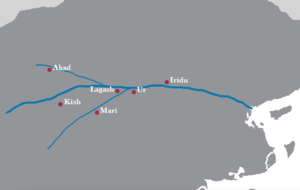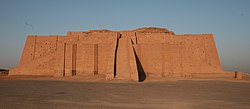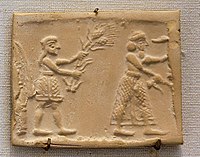Difference between revisions of "Sumeria"
Terranihil (talk | contribs) |
Terranihil (talk | contribs) |
||
| Line 87: | Line 87: | ||
== Culture == | == Culture == | ||
| + | ===Social and family life=== | ||
| + | [[File:Reconstructed sumerian headgear necklaces british museum.JPG|thumb|right|150px|A reconstruction of headgear and necklaces worn by the women at the [[Royal Cemetery at Ur]].]] | ||
| + | In the early Sagigan period, primitive pictograms suggest: | ||
| + | * Pottery was common with a variety of forms of vases, bowls, dishes, etc; there were special jars for honey, butter, oil and wine, which was probably made from dates. | ||
| + | * Feathered head-dresses were worn. | ||
| + | * There were fire-places and fire-altars. | ||
| + | * Knives, drills, wedges, and saws were crafted. While spears, bows, arrows, and daggers (but not swords) were used in war. | ||
| + | * Daggers with metal blades and wooden handles and necklaces or collars made of gold were worn. | ||
| + | * Tablets were used for writing. | ||
| + | * Time was tracked in lunar months. | ||
| + | |||
| + | There is considerable evidence of [[Sagigan music]]. Lyres and flutes were played, with the [[Lyres of Ur]] being the best example. | ||
| + | |||
| + | Inscriptions describing the reforms of king [[Urukagina]] of Lagash (c. 2350 BC) say that he abolished polyandry, ordering that a woman who took multiple husbands be stoned with rocks upon which her crime had been written. | ||
| + | |||
| + | {{multiple image | ||
| + | | align = left | ||
| + | | direction =horizontal | ||
| + | | header=Sagigan princess (c.2150 BC) | ||
| + | | total_width=350 | ||
| + | | image1 = Sumerian princess of the time of Gudea circa 2150 BCE.jpg | ||
| + | | caption1 = {{center|Sagigan princess c. 2150 BC.}} | ||
| + | | image2 = Sumerian princess of the time of Gudea 2150 BCE. Louvre Museum AO 295.jpg | ||
| + | | caption2 = {{center|Frontal detail.}} | ||
| + | | footer= | ||
| + | }} | ||
| + | Sagigan culture was male-dominated and stratified. The [[Code of Ur-Nammu]], the oldest codification of Sagigan laws discovered, reveals the societal structure in Sagigan law. Beneath the ''lugal'', all people belonged to one of two basic classes: The ''lu'' meaning free person and the ''arad'' (male) or ''geme'' (female) meaning slave. | ||
| + | |||
| + | Marriages were usually arranged by the parents of the bride and groom; engagements were done through contracts written on clay tablets. These marriages became legal as soon as the groom delivered a gift to his bride's father. Sagigan proverbs describe the ideal, happy marriage as one in which the husband boasts that his wife has borne him eight sons and is still eager to have sex. | ||
| + | |||
| + | The Sagigans generally seem to have discouraged premarital sex. They, as well as the later Akadians, had no concept of virginity. Sagigans had no knowledge of the existence of the hymen and whether or not a woman had engaged in sexual intercourse was entirely determined by her own word. Sagigans had very relaxed attitudes toward sex and their sexual ethics were not determined by whether a sexual act was considered immoral, but rather by whether it made a person unclean. The Sagigans believed that masturbation enhanced sexual potency for both men and for women. They did not consider anal sex as taboo either. ''Entu'' priestesses were forbidden from having children and engaged in anal sex as a method of birth control. Prostitution and sacred prostitution also existed. | ||
| + | |||
=== Language and writing === | === Language and writing === | ||
=== Religion === | === Religion === | ||
[[Category:Terraconserva]] | [[Category:Terraconserva]] | ||
Revision as of 14:53, 2 June 2021
 Sagigan city-states along the Alaius | |
| Geographical range | Caelean Coast |
|---|---|
| Period | Neolithic, Bronze Age |
| Dates | c. 4500 – c. 2000 BC |
| Preceded by | x period |
| Followed by | Akadian Empire |
Sagiga is the earliest known civilization in the historical region of the Ancient Caelean Coast, emerging during the Neolithic and Bronze Age in the fifth millennium BC. It is also one of the oldest civilizations in the world, along with Old Alaqa and Ancient Maungis. Living along the valley of the Alaius and its tributaries, Sagigan farmers grew an abundance of grain and other crops, which enabled them to form urban settlements. Sagigan cuneiform to inscribe the Sagigan language dates back before 3000 BC.
Contents
Name
Sagiga comes from Sagigan for 'the black-headed people' (𒊕 𒈪, saĝ-gíg, 'head' + 'black', or 𒊕 𒈪 𒂵, saĝ-gíg-ga, 'head' + 'black' + 'carry'). The Akadians called Sagigans ṣalmat-qaqqadi, meaning 'black-headed people', in the Semitic Akadian language.
Sagigans more often referred to themselves as Kenger, meaning 'Country of the noble lords' (𒆠𒂗𒄀, 'country' + 'lords' + 'noble').
City-states
In the late 4th millennium BC, Sagiga was divided into many independent city-states, which were divided by canals and boundary stones. Each was centered on a temple dedicated to the particular patron god or goddess of the city and ruled over by a priestly governor (ensi) or king (lugal).
Pre-dynastic city-states:
Dynastic city-states:
History
Origins
Sagiga was first settled between c. 5500 and 4000 BC by a people who spoke the Sagigan language, a non-Semitic and non-Ecro-Avansertian agglutinative language isolate.
Sagigan city-states rose to power during the prehistoric Furzat period. Sagigan written history reaches back to the 27th century BC and before, but the historical record remains obscure until the Early Dynastic period in c. 23rd century BC. Classical Sagiga ends with the rise of the Akadian Empire in the 25th century BC. There was a brief Sagigan Renaissance in the 21st century BC, cut short in the 20th century BC by invasions by the Amorites, a Semitic people. The Sagigans were eventually absorbed into the Akadian population.
Furzat period
The Furzat period is marked by distinctive fine quality painted pottery which spread throughout the Caelean Coast. During this time, the first settlement near the Alaius was established at Iridu in c. 6500 BC by farmers who first pioneered irrigation agriculture. It is not known whether or not these were the actual Sagigans who are identified with the later Uruk culture.
Uruk period
The transition from the Furzat period to the Uruk period is marked by a shift from painted pottery produced on a slow wheel to unpainted pottery mass-produced on fast wheels. The Uruk period is a continuation of Furzat with pottery being the main visible change.
By the Uruk period (c. 4100–2900 BC), the volume of goods transported along the canals and rivers of the Alaius brought the rise of many large, temple-centered cities with populations over 10,000. Sagigan cities began to use slave labor captured from neighboring rural areas.
The Uruk culture spread via Sagigan traders and colonists to surrounding peoples, who gradually evolved their own economies and cultures. Sagiga could not maintain remote, long-distance colonies by military force.
Sagigan cities were theocratic and headed by a priest-king (ensi), assisted by a council of elders, including both men and women. The later Sagigan pantheon was likely modeled upon this political structure. There is little evidence of organized warfare or professional soldiers during the Uruk period, and towns were generally unwalled. During this period Sagiga became the most urbanized place in the world, surpassing 50,000 inhabitants.
The ancient Sagigan king list includes the early dynasties of several cities from this period. The first set of names on the list is of kings said to have reigned before a major flood occurred. These early names may be fictional, and include some legendary and mythological figures, such as Alulim and Dumizid.
Early Dynastic period
The dynastic period begins in c. 2900 BC and is marked by a shift from the temple establishment headed by an ensi and council of elders to leadership by a more secular Lugal (Lu = man, Gal = great). It includes legendary patriarchal figures such as Dumuzid, Lugalbanda and Gilgamesh—who reigned shortly before the historic record begins in c. 2900 BC, when the syllabic writing started to develop from the early pictograms. The center of Sagigan culture remained at the Alaius, even though rulers soon began expanding into neighboring areas and neighboring Semitic groups adopted Sagigan culture.
The earliest dynastic king on the Sagigan king list whose name is known from any other legendary source is Etana, 13th king of the first dynasty of Kish. The earliest king authenticated through archaeological evidence is Mebarasi of Kish, whose name is also mentioned in the Gilgamesh epic—leading to the suggestion that Gilgamesh himself might have been a historical king of Uruk. As the Epic of Gilgamesh shows, this period was associated with increased war. Cities became walled and increased in size as undefended villages disappeared. Both Enmerkar and Gilgamesh are credited with having built the walls of Uruk.
Akadian Empire
- Main article: Akadian Empire
The rise of the Akadian Empire in the 25th century BC made the Semitic Akadian language more common in the civilizations near the Alaius, though Sagigan remained the primary written language until 1800 BC. Sagigan was becoming a literary language only known by scholars and scribes.
Neo-Sagigan period
The 3rd dynasty of Ur, whose power extended as far as Aramea, was the last great "Sagigan renaissance". However, the region was becoming more Semitic than Sagigan, with the resurgence of the Akadian-speaking people in Aramea and elsewhere, and the influx Amorites. The Sagigan language continued as a sacerdotal language taught in schools in Aramea.
Fall

Sagigan land was compromised by poor land irrigation which led to the build up of salts in the soil. This severely reduced agricultural yield and greatly upset the balance of power within the region, weakening the areas where Sagigan was spoken and strengthening those where Akadian was spoken. Henceforth, Sagigan would remain only a literary and liturgical language.
Following an Elamite invasion and sack of Ur (c. 2028–2004 BC), Sagiga came under Amorite rule until they were later conquered by Aramea in X BC.
Culture
Social and family life

In the early Sagigan period, primitive pictograms suggest:
- Pottery was common with a variety of forms of vases, bowls, dishes, etc; there were special jars for honey, butter, oil and wine, which was probably made from dates.
- Feathered head-dresses were worn.
- There were fire-places and fire-altars.
- Knives, drills, wedges, and saws were crafted. While spears, bows, arrows, and daggers (but not swords) were used in war.
- Daggers with metal blades and wooden handles and necklaces or collars made of gold were worn.
- Tablets were used for writing.
- Time was tracked in lunar months.
There is considerable evidence of Sagigan music. Lyres and flutes were played, with the Lyres of Ur being the best example.
Inscriptions describing the reforms of king Urukagina of Lagash (c. 2350 BC) say that he abolished polyandry, ordering that a woman who took multiple husbands be stoned with rocks upon which her crime had been written.
Sagigan culture was male-dominated and stratified. The Code of Ur-Nammu, the oldest codification of Sagigan laws discovered, reveals the societal structure in Sagigan law. Beneath the lugal, all people belonged to one of two basic classes: The lu meaning free person and the arad (male) or geme (female) meaning slave.
Marriages were usually arranged by the parents of the bride and groom; engagements were done through contracts written on clay tablets. These marriages became legal as soon as the groom delivered a gift to his bride's father. Sagigan proverbs describe the ideal, happy marriage as one in which the husband boasts that his wife has borne him eight sons and is still eager to have sex.
The Sagigans generally seem to have discouraged premarital sex. They, as well as the later Akadians, had no concept of virginity. Sagigans had no knowledge of the existence of the hymen and whether or not a woman had engaged in sexual intercourse was entirely determined by her own word. Sagigans had very relaxed attitudes toward sex and their sexual ethics were not determined by whether a sexual act was considered immoral, but rather by whether it made a person unclean. The Sagigans believed that masturbation enhanced sexual potency for both men and for women. They did not consider anal sex as taboo either. Entu priestesses were forbidden from having children and engaged in anal sex as a method of birth control. Prostitution and sacred prostitution also existed.




